Apple is commercially the most important temperate fruit and is fourth among the most widely produced fruits in the world after banana, orange, and grape. Kashmir, proudly known as the paradise of the earth, is also home to temperate fruits like an apple, for which the state is very famous across the globe. As a result, Kashmiri apples hold a unique position in the global marketplace. Indirectly and directly, it constitutes almost 60% of Kashmir’s income.
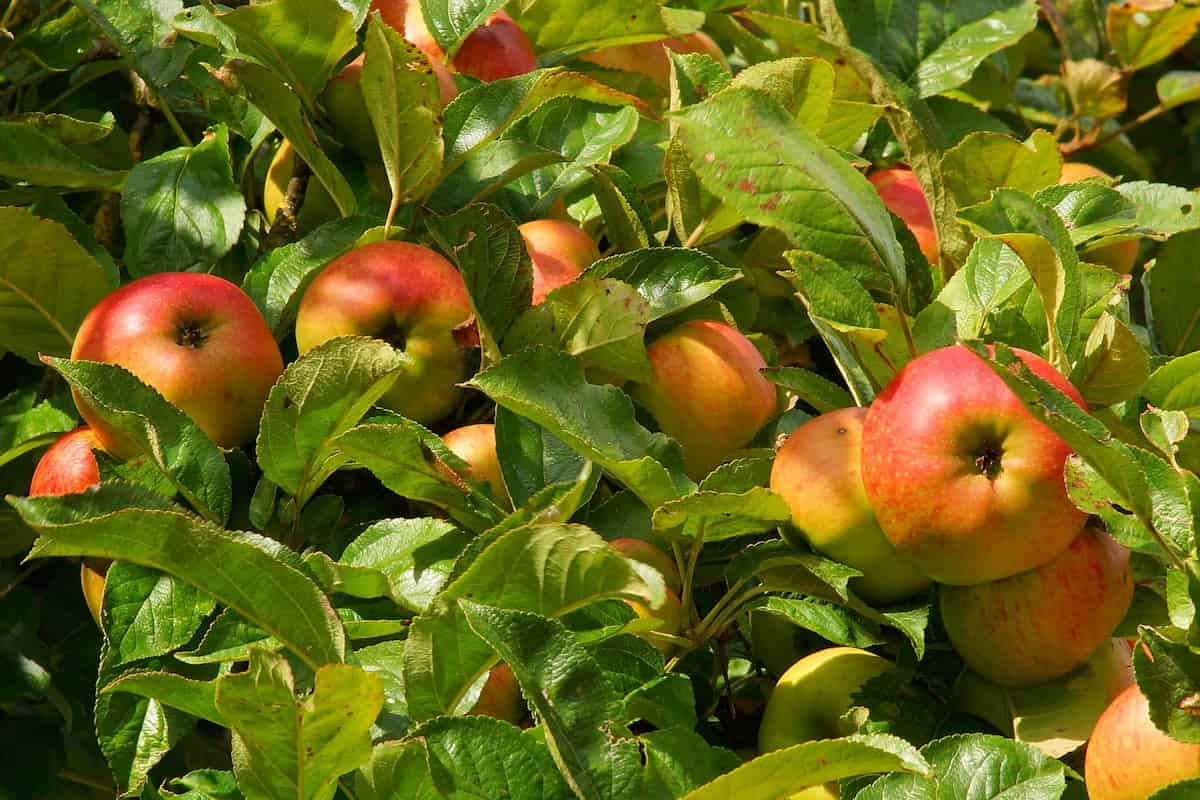
The main factor influencing temperate fruit-bearing trees like apple is soil, climate, and environment, which are highly favorable and unparalleled in the province of Kashmir. In addition, Kashmir is known for its scenic beauty, fine handicrafts, and delicious fruits – walnuts, almonds, cherries, and peaches. Out of these, apple cultivation is the primary producer.
Kashmiri Apple cultivation in India
Apple has grown only at a higher elevation
Hence apple is grown only at higher elevation where the temperature drops to a very low level which is highly required for the growth of such bearing trees. Thus, the Indian subcontinent of the Himalayan region, especially the state of Kashmir, which is noted for its monsoon, is supposed to be the most favorable location for the growth of not only apples but also other temperate fruits.
Kashmir has a distinct identity of having an unbroken hist record for its temperate weather conditions from the early days to the present period. It is believed that things which are difficult to be got even in heaven, like houses, saffron (crocus), grapes, icy water, and apples are easily available here. The freely available fruits of the state form an important part diet of the people.
Types of Kashmiri Apples
As far as Kashmiri apples are concerned, seven types are grown commercially. There are delicious and Kulu Delicious, Kinor, Golden, Jonthon, Maharaji, American, Ambri, Balgaria, and Trel varieties
Delicious
- Delicious is one of the most famous Kashmiri apple varieties. The Delicious Apple is the most popular and widely grown apple variety in Pulwama, Shopian, Kulgam, and Sopore in Kashmir.
- Delicious Apples are mostly found in Shopian and some hilly areas of the Kulgam district. The valley produces large quantities of it, however.
- There is a blush red color to the skin of delicious, and its texture is smooth. In addition to being greenish-white and grained, the flesh of the Red Delicious apple is sweet and juicy. Aside from its crispiness and aroma, it also appealed to the eye.
- Fruits can range in size from medium to large. From mid-September to October, the fruit is abundant in the local market after it ripens.
Kullu delicious
- Kulu Delicious is the second-most commonly produced Kashmiri apple variety. The color of its skin is reddish or dark red.
- Due to its color, this apple costs slightly more than the delicious apple. There is, however, a slight difference in taste between Kullu delicious and a delicious apple.
Kinnaur
- The third-largest apple produced in Kashmir is Kinor, and its color is more attractive than the Kullu delicious. However, the market value of this apple is also greater than delicious and similar to the Kullu delicious.
- apples encompass wide varieties ranging from small to large and from round to oblate to conical.
- The skin can be waxy, glossy, or smooth and in red, green, yellow, or orange hues. The flesh can be firm, pale yellow to cream-colored, juicy, crunchy, or crisp.
Golden delicious Apple
- The golden delicious apple is a conical-shaped, small, and medium-sized fruit known for its freshness and longer shelf life. The apple is crispy, white, juicy, thick, and green and turns yellow as it ripens.
- Its sweet taste and smooth texture make it an excellent ingredient for desserts. Late October through January is the time when this variety ripens.
Jonathon
- Jonathon, also known as Red Golden, is another popular apple variety grown specifically for pollination purposes.
- It has a similar shape to the golden apple but a different color. There is something similar to dark pink in the color of this apple. In addition, it tastes great and is very juicy. Additionally, it has a good market value.
In case you missed it: State Wise Tomato Farming Seasons in India: Growing Best Varieties and Production Yield
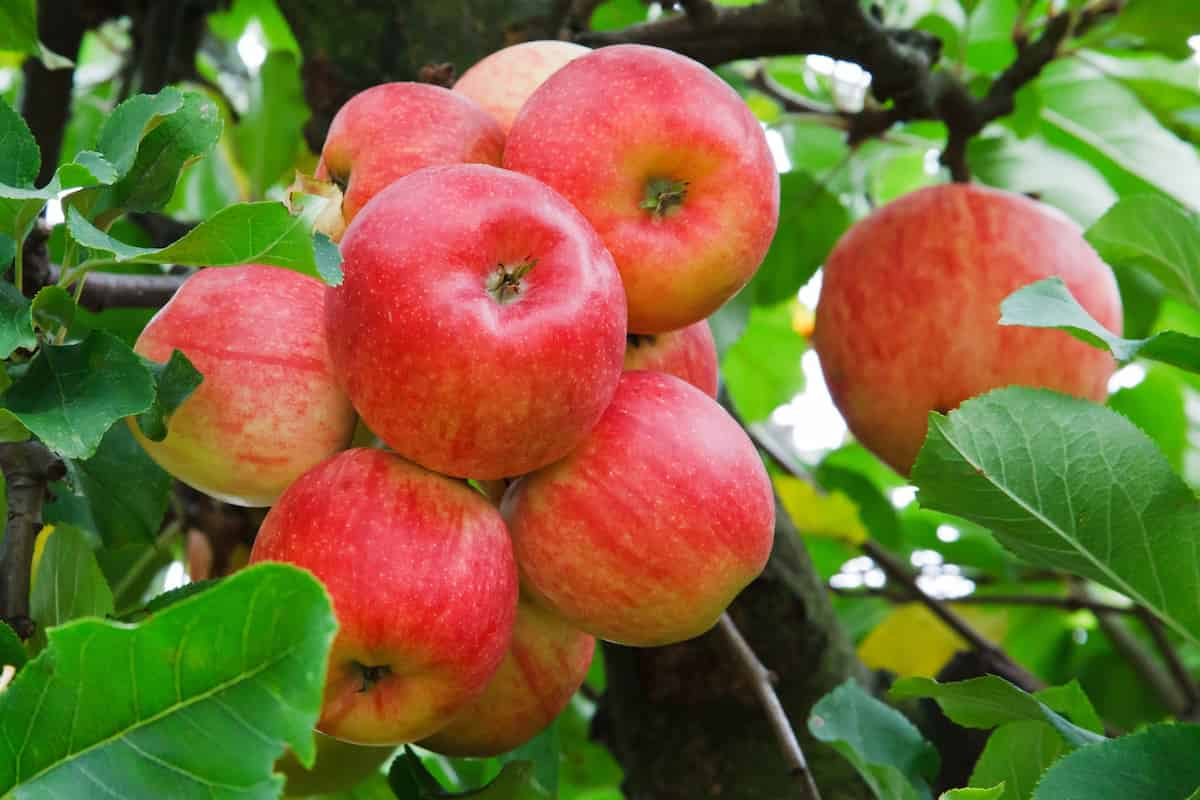
Maharaji
- Maharaji Apples are large, red apples with a green base. There are some conspicuous dots on it.
- This fruit has a crisp, juicy, and aromatic skin but an acidic taste. With time, this variety ripens in late October, remains fresh longer, and becomes sweeter.
Ambri Kashmir
- Among the apples grown in the Himalayan hills, Ambri is considered to be the most popular and indigenous.
- It is known for its crispiness, aroma, flavor, and attractiveness. This kind of apple usually ripens in October and stays fresh for a long time.
- Ambri Apples are blush red, slightly striped, medium in size, and conical. During this period, Ambri apples have grown less in the Himalayan Hills, while production has increased in Shopian and Kulgam.
Bulgaria
- Bulgaria is a hybrid apple variety grown for pollination. The taste is very sweet and sugary. The market value of the product is also fine, in the mid-range range.
American Trel
- This type of apple is small, round, and quite juicy. The American Trel, on the other hand, is very sweet and crispy.
- The fruit’s skin is white, greenish, and sweet. The apple ripens in September and is available by mid-September.
- It is comparatively cheaper and offers good taste in desserts. Due to its absolute shape, red color, and lower price, this variety is popular with customers.
Climate required for growing Shimla Apples
Crop growth is highly dependent on the climate. For apple farming to produce high yields, farmers must also understand the climate requirements. Growing apple crops at altitudes between 1,500 and 2,700 meters above sea level is possible. It is recommended that apple trees be grown at a temperature between 21°C and 24°C.
Apple trees that give the best growth and fruiting need 100 cm to 125 cm of annual rainfall. You should, however, keep in mind that too much rainfall and fog near the fruit maturity period will reduce the quality and color of the fruit. Additionally, it causes fungal spots on apple fruit. Apple farming is also not suitable for high-velocity winds.
Soil requirement for Apple cultivation
Growing apple trees in medium-textured clays and gravelly sands is possible, but loamy soil is the best for apple trees. Besides holding moisture well, loam soil also drains well. The chance of root and crown rot increases if the soil doesn’t drain well. Furthermore, a lack of good drainage can hinder root growth. A pH of 5.8 to 7.0 is ideal for apple trees, but slightly acidic soil is preferable.
Planting methods of Apple farming
In preparation for planting, 60 cm pits are dug two weeks in advance. It is filled with good loamy soil and organic matter. Plants are placed in the center of the pit by scooping the soil and placing the soil ball, keeping the roots intact. Loose soil is filled and lightly pressed in the remaining area to remove air gaps.
Seedlings are staked and watered immediately after planting. An acre of land may contain 80 to 500 plants on average. There are four categories of planting density, namely: low density (less than 120 apple plants per acre), moderate density (120 to 200 apple plants per acre), high density (200 to 520 plants per acre), and ultra-high density (more than 520 plants per acre).
In case you missed it: Honey Dew Papaya Farming in India: How to Start, Care, Pest, and Disease Management
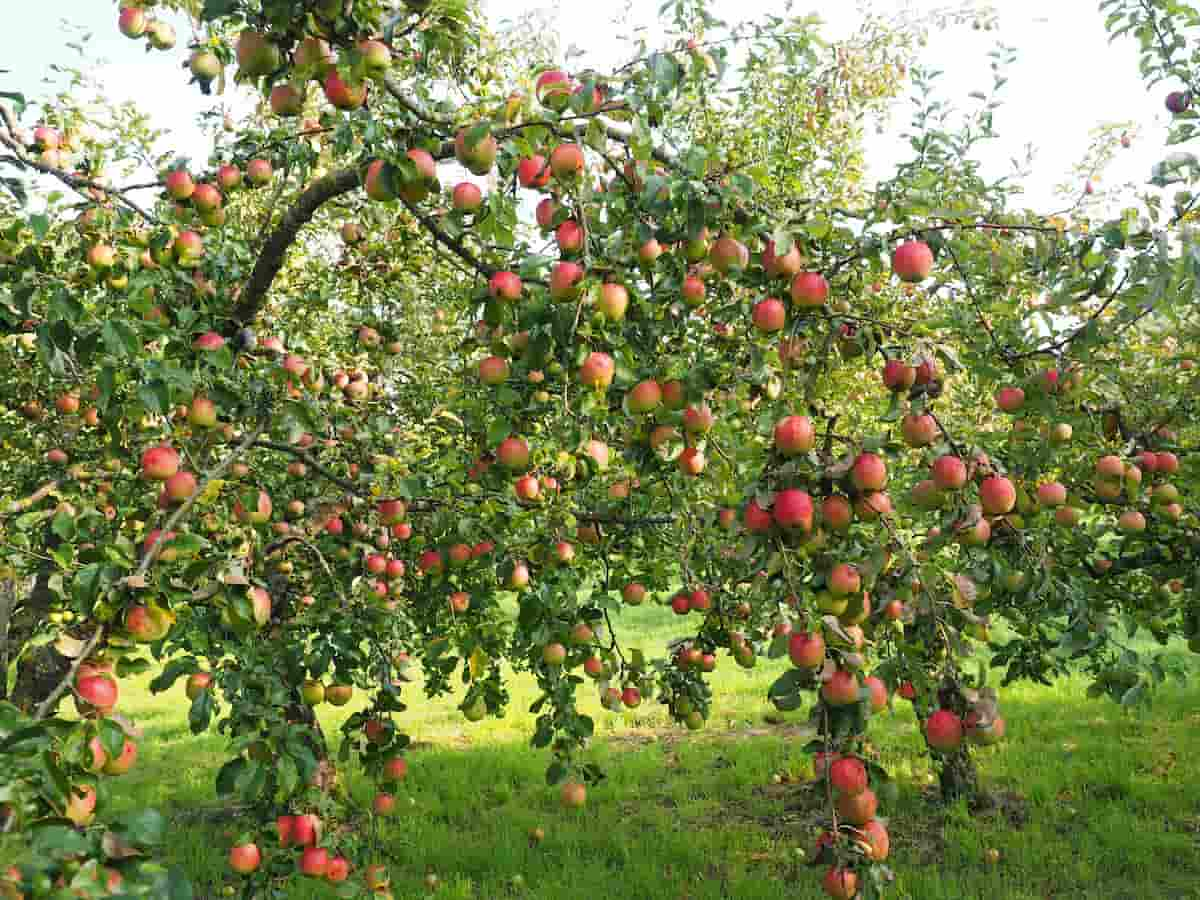
The combination of scion and rootstock variety determines Apple plant spacing and planting density. Between October and November, burrow pits measuring 1 m x 1 m x 1 meter are ready for planting. A mixture of 30 kg to 40 kg Farm Yard Manure (FYM), 500 grams of Single Superphosphate, and 50 grams of Malathion dust is added to each pit after it has been blended properly. After mixing properly, 30 kg to 40 kg of Farm Yard Manure (FYM), 500 grams of Single Superphosphate, and 50 grams of Malathion dust are added to each pit. Follow one irrigation immediately after apple farming.
Irrigation requirements for Apple farming
Low soil moisture is particularly detrimental to apple trees. As a result of water stress during the growing season, the number and size of fruits are reduced, and the June drop is increased. Apples must receive uniform distributions of rain throughout the year; supplementary irrigation should be provided during critical periods if there are dry spells. During times of water stress, fruit sets are poor, fruit drops are heavy, production is low, and quality is poor.
When it comes to water requirements, the most critical period is from April to August, and the peak water requirements are after the fruit has been set. December-January is the usual season for irrigating orchards after they have been manured. During the summer, the crop is irrigated every 7-10 days. It is necessary to irrigate the crop every week after the fruit set. The color of the fruit is markedly improved by watering in the fortnight before harvest. In the following weeks, irrigation will occur every three to four weeks until dormancy begins.
Fertilisation and applications of Manures
- It is applied with different composts, 10 kg of farm yard manure (FMY) every year based on the tree’s age. Therefore, it is recommended to apply 70:35:70 grams of K, P, and N per year (during the tree’s life).
- Following ten years of tree age, the K, P, and N portions should be settled at 700:350:700 grams each.
- During an “off” year (when harvest load is low), the standard compost portion of K, P, and N is 400 grams, 250 grams, and 500 grams, respectively.
- It is recommended to use compost to avoid deficiency of boron, zinc, manganese, and calcium.
Weed management in Apple cultivation
Apple trees require weed-free competition for at least part of the year, especially during the initial establishment years, to maximize vegetative growth and fruit production. Apples have relatively deep roots compared to many weed species. However, changes in orchard architecture to favor dwarf rootstocks with shallow root systems make those trees less competitive with weeds than older, larger trees on semi-dwarfing or larger rootstocks. A sod ground cover with an offset mower may be acceptable for those larger, established trees.
However, grasses and other covers growing under the trees may compete for water and nutrients and reduce crop yield and tree growth in subtle but measurable ways. Therefore, even deep-rooted semidwarf trees will benefit from reduced weed competition during orchard establishment. Weed control in apple farming by Involving Gammaxone/Paraquat (0.5% ) or glyphosate at 800 ml/ha as the post-emergence herbicide will kill the weed maturing for 4 to 5 months.
In case you missed it: How to Start Alphonso Mango Farming in India: A Cultivation Guide to Planting to Harvesting
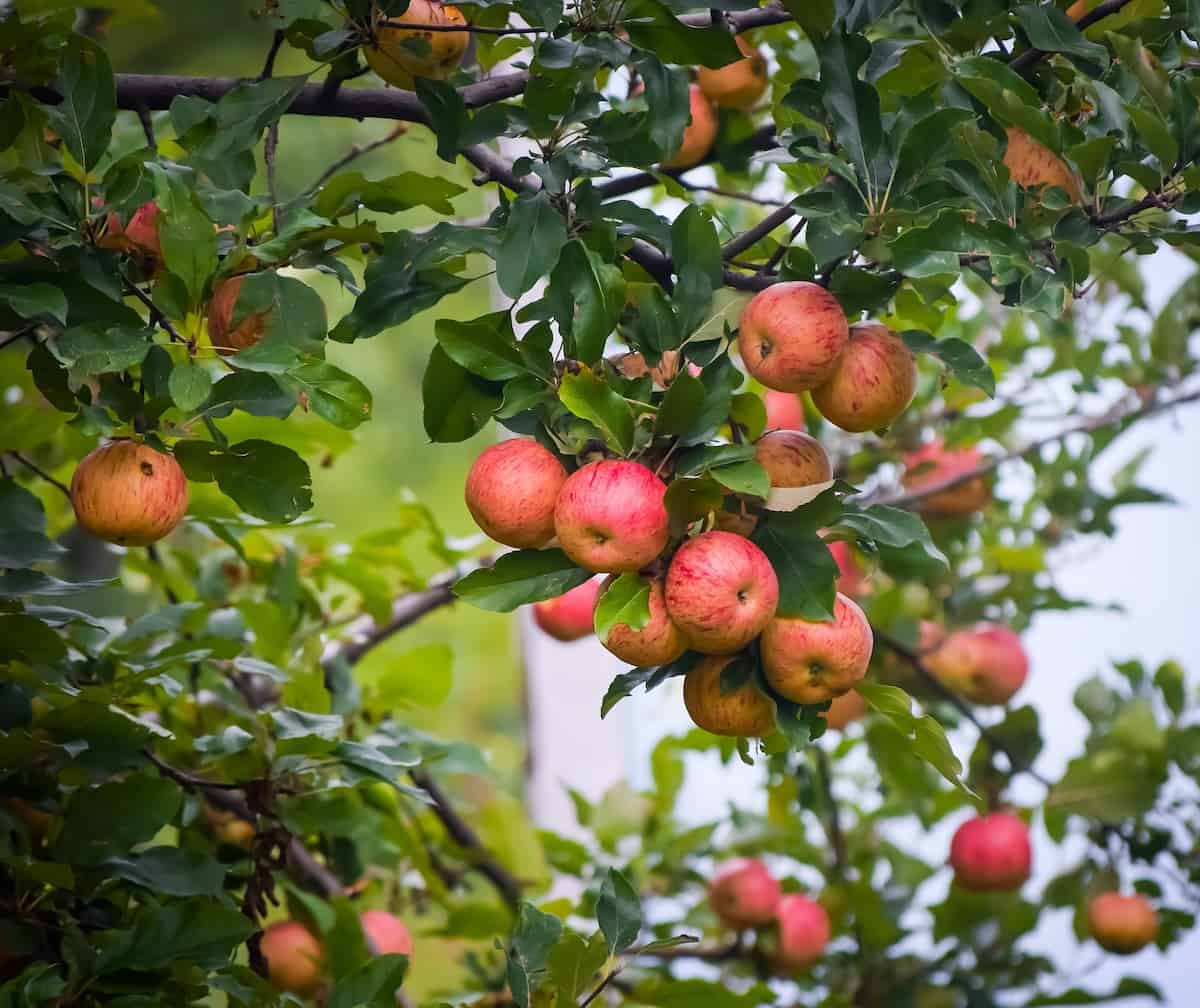
Intercropping
Green manuring crops like beans and sunflowers can be cultivated in the early years of apple farming to increase soil texture and nutrients. e concluded that apple-soybean and apple-peanut intercropping systems could be practical and beneficial in the region.
Training and pruning
- Timely training and pruning activity are required for proper growth and good-quality apples.
- The apple plants are trained as per the growth habit and vigor of the rootstocks. In addition, the standard apple trees are trained on a modified central leader system to receive proper light.
- This improves apple fruit color and also minimizes the effect of heavy snowfall and hail.
- The spindle bush system is best suitable for high-density apple planting under mid-hill conditions.
Thinning
Thinning is one of the most common techniques used to regulate fruit quality. Heavy bearing results in small, poor-quality fruits and alternate bearing cycles in apples. By thinning fruit at the right stage of development, cropping can be regulated, and fruit size and quality can be improved. However, manual thinning is cumbersome and expensive, so chemical thinning is used instead.
Using chemical thinners in hot and dry conditions is not recommended since they adversely affect absorption. Instead, thorough spraying should be done to cover the entire canopy. In some cases, chemical thinning is caused by calcium deficiency. Consequently, nutritional calcium supplementation should be provided after thinning. For every 40 leaves, it is advisable to retain one fruit. Therefore, each spur will have only one fruit and be spaced 15 to 20 cm apart.
Pests in Apple farming
Codling moth
Damage symptoms
- This natural pest severely damages the fruit.
- Through the calyx, neonate larvae enter the fruit and feed on its seeds.
- The fruit loses its shape and falls down prematurely if it is infested.
- Between 30 and 70 percent of apple fruits are unmarketable.
Control and management
- The infested fruits and cocoons should be collected and destroyed
- Release egg parasitoids, Trichogramma embryophagum, at a rate of 2000 per acre
- Spray DDVP 0.04%
- Diazinon and acetempride should be applied four times per season during egg laying
Apple stem borer
Damage symptoms
- Caused by grub and adult, grub is more destructive
- Grub makes a tunnel and reaches close to the trunk of the tree.
- The vitality and productivity of the plant are greatly impaired.
Chemical control and management
- Before the grubs enter the tree trunk, prune the branches containing them
- The grub will be killed by injecting 10 ml of monocrotophos 36 WSC and plugging the hole with wet clay
Woolly aphid
- Nymphs and adults suck the juice from the bark of the trunk or fruits
- Weakening and death of the smaller plants
- Infested twigs shrivel and die
- Galls on the roots
- White, woolly patches on the trunk.
In case you missed it: Shimla Apple Farming in India: Cultivation Practices, Planting to Harvesting, and Production
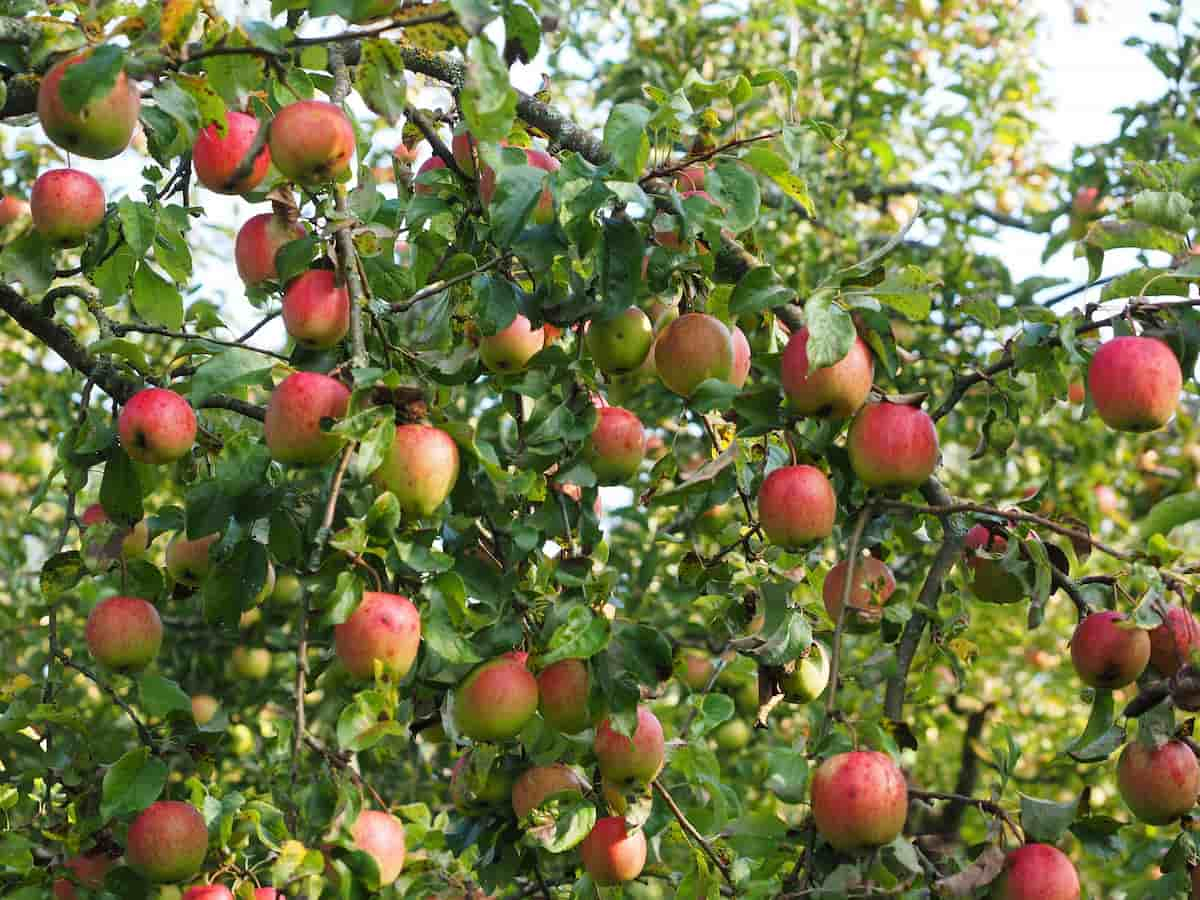
Chemical control and management
- It is recommended to spray dimethoate 30 EC 0.06% or methyl demeton 25 EC 0.025
- Release Aphelinus mali, the parasitoid
- Coccinella septumpunctata and Chilomenus bijugus are predators
San Jose scale
Symptoms of damage
- Reddish pink coloration of the infested area of bark
- Fruits discolored purple.
- Young trees or branches with infested shoots lose vigor and die.
Management
- Summer spray with phosalone 50 EC 0.05% or fenitrothion 50 EC 0.05%
- Winter spray with diesel oil emulsion at 8-12 l/ tree ( diesel oil 4.5 l, soap 1 kg, water 54 -72 l)
- Encourage the activity of parasitoids: Prospaltella pernicious and Aspidiotophagus sp
- Field release of coccinellid, Chilocorus circumdatus predator
Diseases in Apple farming
Fire blight: Erwinia amylovora
Damage symptom
- Symptoms usually appear on leaves, which become water-soaked, wither, turn brownish to black, and fall from trees.
- Twigs were affected by the symptom. The terminal twigs wilt downward and spread to the branches as well.
- Fruits become water-soaked, turn brown, fade, and finally become black.
- Oozing may be seen in the affected area.
Management
- Removal and destroy affected parts.
- Removal of blighted twigs
- Spray with Streptomycin 500 ppm.
Sooty blotch and flyspeck
Sooty Blotch
Sooty blotches appear as sooty or cloudy spots on fruit surfaces. Olive-green blotches with an indefinite outline appear. There is usually at least a one-quarter-inch diameter to the scars, which can merge to cover much of the fruit. Generally, the sooty blotch fungus affects the cuticles on the outer surface. However, the hyphae can penetrate the epidermal cell walls in rare cases.
Flyspeck
Apple fruits are covered with raised, black, shiny, round dots resembling fly excreta. Unlike the pycnidia of the sooty blotch fungus, the individual “fly specks” are more widely scattered.
Control methods
- Potassium bicarbonate (KHCO3 ) is a new, moderately effective fungicide to control sooty blotch/flyspeck.
- Potassium bicarbonate is a more effective treatment for controlling apple diseases, particularly powdery mildew in organic orchards.
Alternaria rot: Alternaria alternate
Damage symptoms
- Typical rot symptoms of this disease are nearly round, brown to black lesions, often centered around a skin break or weakened tissue.
- The spots are firm, dry, and shallow.
- The surface of the spots becomes dark brown to black, and in the advanced stages, the rotted tissues become spongy, and the affected flesh turns black.
Chemical control and management
- Practice orchard sanitation and “soft handling” of fruit.
- Harvest fruit at proper maturity.
- Careful handling during picking, washing, and packing
- Store fruits at temperatures of 0° to 4 °C.
In case you missed it: Grand Nain (G9) Banana Farming in India: A Cultivation Guide to Planting to Harvesting
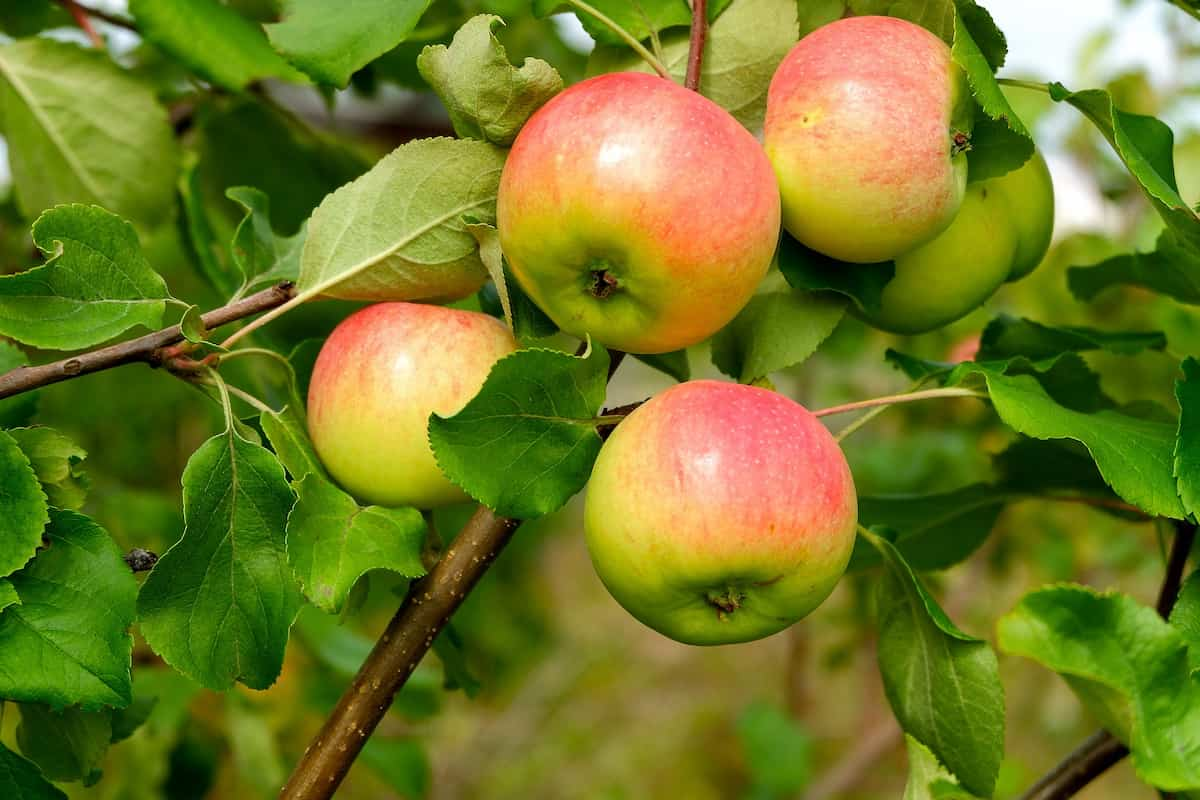
Harvesting
Apples are generally ready for harvest in September-October, except in the Nilgiris, where the season runs from April to July. Depending on the variety, the fruits take 130-150 days to mature after the full bloom stage. A fruit’s ripening is characterized by its color, texture, and flavor change.
The fruits need to be uniform, firm, and crisp when harvested. At maturity, the skin is yellow-red, depending on the variety. The optimum harvest time depends on the fruit quality and the intended storage period. As a result of dwarf rootstocks being introduced, hand picking is recommended as it reduces bruising caused by fruit fall during mechanical harvesting.
Conclusion
Depending on the apple varieties produced (commonly referred to as “cultivars”), most apples are harvested and marketed from late August through October. If regular cold storage is used, the marketing season can be extended through March. If controlled-atmosphere (CA) storage is available, the marketing season may be extended through July. Apples may be sold directly to consumers, marketed wholesale to packers, or sold to processors.
- Types of Pesticides Used in Agriculture: A Beginner’s Guide
- Economical Aquaculture: A Guide to Low-Budget Fish Farming
- 15 Common Planting Errors That Can Doom Your Fruit Trees
- How to Make Houseplants Bushy: Effective Tips and Ideas
- Innovative Strategies for Boosting Coconut Pollination and Yield
- Pollination Strategies for Maximum Pumpkin Yield
- The Complete Guide to Chicken Fattening: Strategies for Maximum Growth
- Natural Solutions for Tulip Problems: 100% Effective Remedies for Leaf and Bulb-Related Issues
- Revolutionizing Citrus Preservation: Towards a Healthier, Greener Future
- Natural Solutions for Peony Leaf and Flower Problems: 100% Effective Remedies
- Maximizing Profits with Avocado Contract Farming in India: A Comprehensive Guide
- Natural Solutions for Hydrangea Problems: 100% Effective Remedies for Leaf and Flowers
- The Ultimate Guide to Choosing the Perfect Foliage Friend: Bringing Life Indoors
- From Sunlight to Sustainability: 15 Ways to Use Solar Technology in Agriculture
- The Ultimate Guide to Dong Tao Chicken: Exploring from History to Raising
- The Eco-Friendly Makeover: How to Convert Your Unused Swimming Pool into a Fish Pond
- Mastering the Art of Delaware Chicken Farming: Essentials for Healthy Backyard Flocks
- 20 Best Homemade Fertilizers for Money Plant: DIY Recipes and Application Methods
- How to Craft a Comprehensive Free-Range Chicken Farming Business Plan
- Brighten Your Flock: Raising Easter Egger Chickens for Beauty and Bounty
- How to Optimize Your Poultry Egg Farm Business Plan with These Strategies
- Subsidy for Spirulina Cultivation: How Indian Government Schemes Encouraging Spirulina Farmers
- Ultimate Guide to Raising Dominique Chickens: Breeding, Feeding, Egg-Production, and Care
- Mastering the Art of Raising Jersey Giant Chickens: Care, Feeding, and More
- Ultimate Guide to Raising Legbar Chickens: Breeding, Farming Practices, Diet, Egg-Production
- How to Raise Welsummer Chickens: A Comprehensive Guide for Beginners
- How to Protect Indoor Plants in Winter: A Comprehensive Guide
- Ultimate Guide to Grow Bag Gardening: Tips, Tricks, and Planting Ideas for Urban Gardeners
- Guide to Lotus Cultivation: How to Propagate, Plant, Grow, Care, Cost, and Profit
- Agriculture Drone Subsidy Scheme: Government Kisan Subsidy, License, and How to Apply Online
- Ultimate Guide to Raising Araucana Chickens: Breed Profile, Farming Economics, Diet, and Care
- Bringing Hydroponics to Classroom: Importance, Benefits of Learning for School Students
- Ultimate Guide to Raising Polish Chickens: Breed Profile, Farming Economics, Diet, and Care
- Ultimate Guide to Raising Australorp Chickens: Profile, Farming Economics, Egg Production, Diet, and Care
- Silkie Chicken Farming: Raising Practices, Varieties, Egg Production, Diet, and Care
- Sussex Chicken Farming: Raising Practices, Varieties, Egg Production, Diet and Care